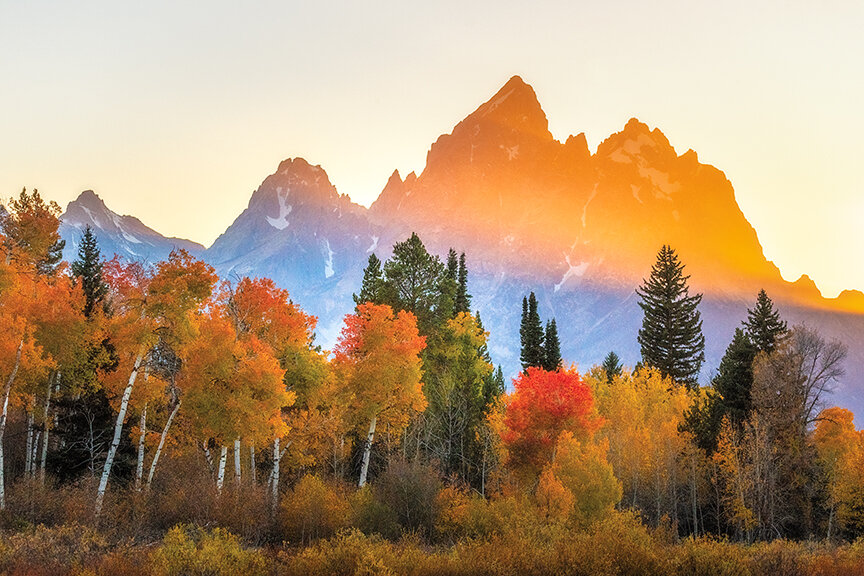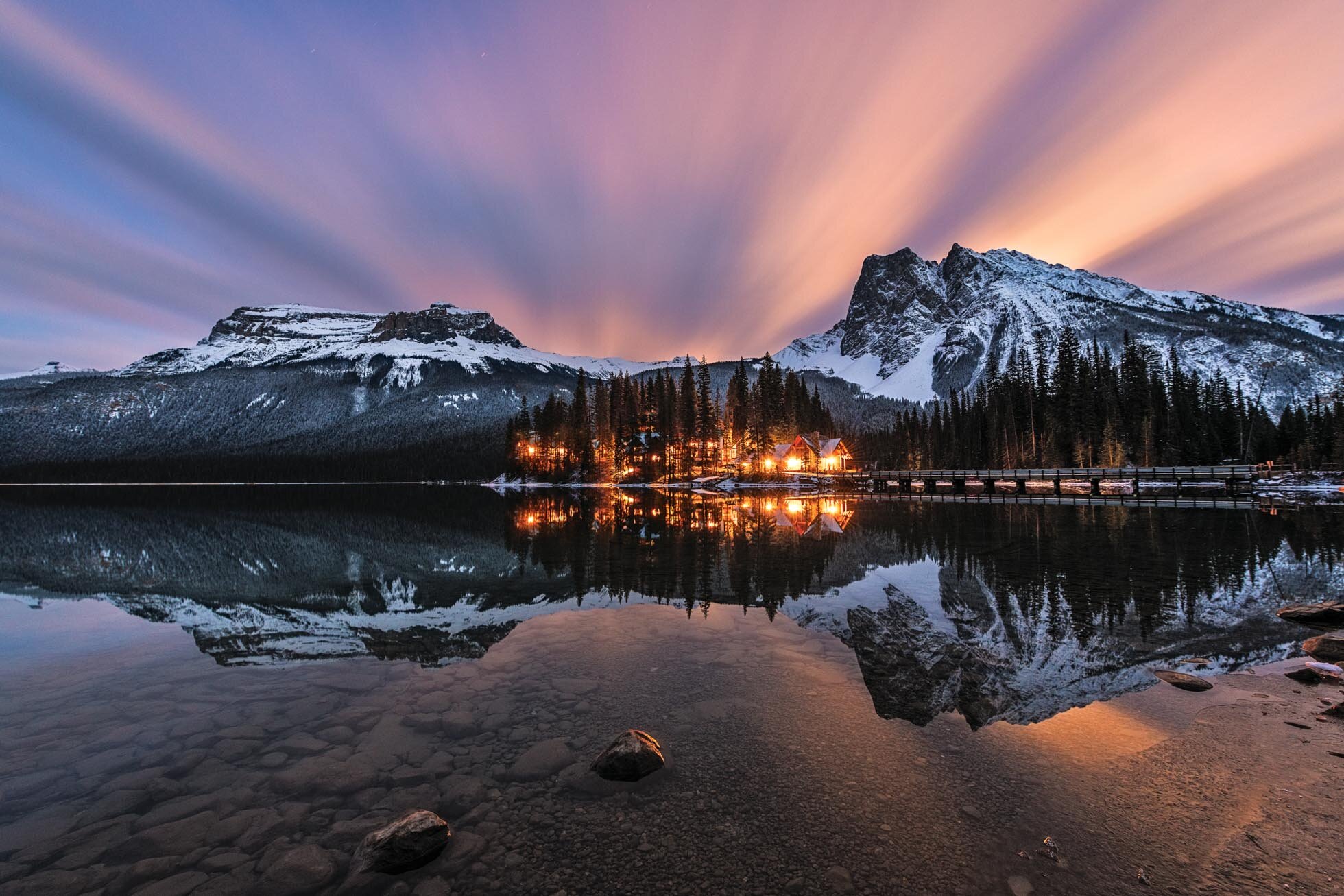Autumn is here and it is a glorious season! I wanted to share some tips for capturing all things fall. With its crisp air and golden foliage, autumn is the perfect time to get out on the trails or take a drive through nature with your camera. The light and colors of fall offer so many opportunities regardless of weather. Here are some technical and creative tips to consider while you capture the season.
1) Emphasize Color - Obviously the first thing that comes to mind when we think of autumn is color. The autumn colors of yellow, orange and gold shine in sunlight and contrast so beautifully with a vibrant blue sky. When photographing the color, it can be effective to isolate the golden color and fill the frame with the beautiful fall colors. Or mix the golden colors with blue of skies or water to create stunning depth and striking contrast.
The warmth of the orange trees contrast with the cool tones of the mountains and blue sky in Grand Teton National Park.
The mix of yellow, orange and red drew my eye right into this scene.
2) Get out in Golden Hour - The golden hour light adds a beautiful warmth to all scenes but the way it makes autumn colors glow is just magical. Get out early for sunrise or at the end of day for sunset. A benefit is that during this season, the sunrise is getting later in the morning and sunset earlier in the evenings.
The setting sun lights the tips of the Tetons and illuminates the fall foliage in the foreground.
3) Grab a Telephoto Lens - A telephoto lens is a perfect choice for capturing details and intimate landscapes. Longer focal lengths can bring you closer to far away scenes or they can isolate details that get lost in the grander scene. A macro lens is also great for capturing details of closer subjects.
Captured from the parking lot at Oxbow Bend in Grand Teton National Park, a 260mm focal length with my Sigma 150-600 allowed me to isolate this beautiful hillside of fall color.
4) Consider Abstract - Consider using a slow shutter speed and intentional camera movement to create abstract images of the fall trees and foliage. Experiment with various focal lengths and with faster and slower movement for different looks. Use a vertical movement with trees. Try zoom blur for an intriguing look. For zoom blur, try a 1 second shutter speed starting at one focal length and twist through the focal lengths while the shutter is open.
Intentional Camera Movement in a grove of Aspens in Wyoming. A 1 second shutter speed with very slow movement created this painterly effect while maintaining some detail of the scene.
5) Bring A Polarizing Filter - I always keep a polarizing filter in my bag and I love it in the fall. A polarizer will cut glare and enhance the vibrance of the fall colors and blue sky. Be careful with wide angle lenses as the polarizing effect is inconsistent across the frame with wide angles.
6) Embrace a Mix of Seasons - The full glow of autumn is stunning but the clash of the seasons can also create wonderfully compelling images. Whether this is a golden tree glowing amongst a sea of green or an early snow that provides a mix of autumn and winter, embrace the atmosphere.
Immediately following peak fall color one year, a stunning snowfall clung to the trees. I used a 200mm focal length to isolate the details and clashing of winter and fall.
A single tree glows with gold amongst the green
7) Look for Reflections - Reflections are a favorite of mine to look for in all seasons, but especially in the fall. Colorful foliage reflecting in the water of lakes and ponds adds additional color and pop to any autumn scene. Look for reflections on days with minimal wind. Early mornings or late evening are the best time to find calm waters.
Fall colors reflect in the Snake River at Oxbow Bend in Grand Teton National Park Sept 2020.
8) All Weather brings unique opportunities! Sunny days offer beautiful blue skies to contrast with the golden color. The sun brings out the glow of autumn colors. Consider closing down your aperture to create a sunburst through the trees or in the sky.
The sun shines through the East Woods at Morton Arboretum on a perfect autumn day.
Stormy weather creates incredible atmosphere and dark storm clouds create a beautiful contrast with the warmth of red, yellow and orange fall foliage.
The stormy clouds create a dramatic atmosphere behind the Tetons as they contrast with the warmth of the golden trees and grasses in the foreground.
Overcast weather may hinder grand landscape opportunities but is an excellent opportunity to seek out waterfalls, rivers or streams for long exposure photography. The lack of bright sun eliminates dappled highlights and the soft lighting allows you to push vibrance of the fall colors in post processing. I always have a polarizer and a 6 stop ND filter with me when I shoot waterfalls and rushing water. I shared about one of my favorite tools, the X4 CPL by Breakthrough Photography, in this blog post.
A slow shutter speed captured the soft flow of the waterfall and a polarizer cuts the glare on the foreground leaves.
Hope these tips help you take advantage of the beauty of autumn. It is a wonderful time of year to get out and photograph all the days have to offer!
Kristen Ryan is an award winning and published landscape and fine art photographer and educator residing in the Midwest suburbs of Chicago. All images are available for purchase in the Fine Art Store or by request. Kristen leads ladies landscape photography retreats in the Tetons, Chicago, and the Canadian Rockies, offers private mentoring and teaches an online landscape photography workshop, The World Around You.































